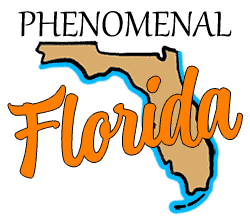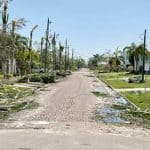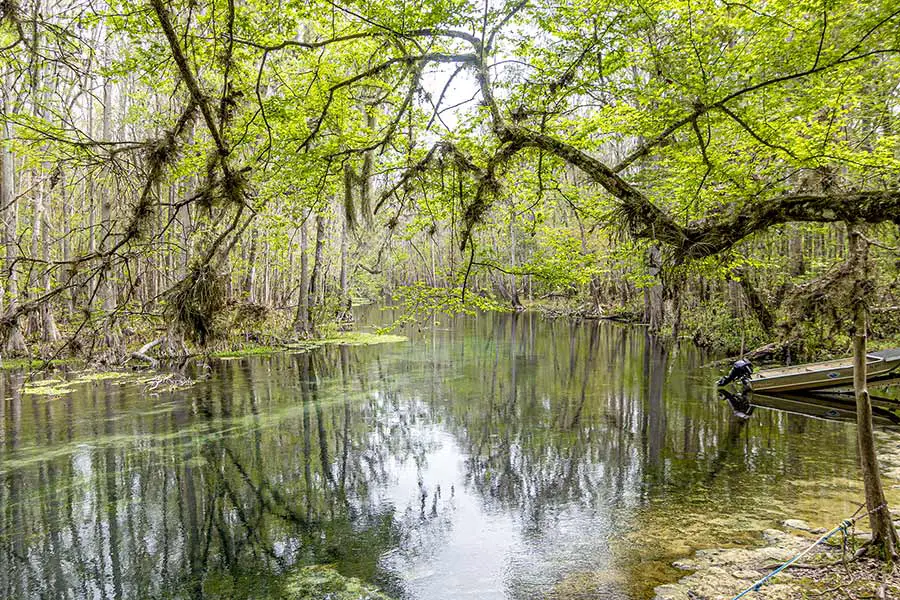
The Suwannee River is a massive, long, and strikingly beautiful river that winds all the way from the Okefenokee Swamp in Georgia down to the Suwannee Sound, just north of Cedar Key, Florida. But can you boat the entire Suwannee River?
The entire Suwannee River is navigable to paddle-driven craft like canoes and kayaks. Powered vessels can travel as far north as Ellaville, Florida, during high-water seasons from the Gulf of Mexico but often must stop short near Branford. Water levels on the river vary with seasons and local conditions.
So can you see manatees or alligators in the Suwannee River? Is it freshwater or saltwater? Can you make wake, or is the whole thing a no-wake zone? The Suwannee River is a fascinating place; as you continue on, you will learn the answers to these questions plus a whole lot more.
From Swamp to Gulf: Riding the Suwannee River
The Suwannee River begins in the Okefenokee Swamp, which is located near Fargo, Georgia. The Suwannee runs about 246 miles from Fargo to its final terminus in the Gulf of Mexico near Suwannee, Florida, just north of Cedar Key. The river passes by and exchanges water with several other major waterways, including the Alapaha River, the Santa Fe River, and the Withlacoochee River.
The 246 miles of the Suwannee River are not linear. The river winds and curves along its path from the Okefenokee to the Gulf. The river’s twists, turns, and switchbacks make it super fun to paddle and play on. You never know what’s around the next bend!
The depth of the Suwannee River varies depending on the season. The dry winter months cause water levels to drop, and the rains of summer pump it back up. On average, however, scientists say that the depth of the river is about 6.6 feet.
While the river is generally well-behaved, heavy storms can cause the Suwannee to flood. Flood stages vary at different points along the river, but flooding can be severe in some places. For example, the buildings at Lafayette Blue Springs State Park in Mayo, Florida, are built on stilts so they can weather the floodwaters – during floods, guests may find that parts of the park are only accessible by kayak.
Kayaks, Canoes, and… Houseboats?
The portion of the Suwannee River north of the Ellaville, Florida area is not considered passable to powered vessels. There are some parts of the river that might require portage and other spots that have rapids, shallows, rocks, and other hazards that would turn a fun day of boating into a not-so-fun-day of filling out insurance paperwork and dealing with water rescue.
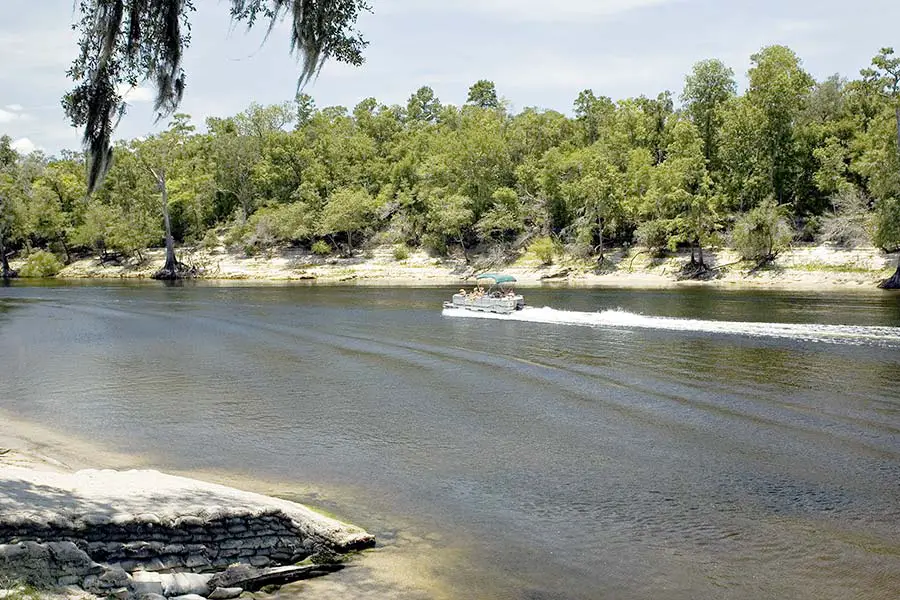
Your best bet for the northern portion of the Suwannee River is to paddle your canoe or kayak. In fact, many people like to paddle the whole length of the river, a voyage that can take anywhere from a week to as much as two weeks.
That said, if you prefer boats with motors, the chunk of the Suwannee River between the Ellaville area and the Gulf of Mexico is generally navigable by powered vessels. Floridians love to boat, and people bring all kinds of boats out onto the river, ranging from center-console fishing boats to day-cruisers and pontoon boats.
Motorboats are fun, but if you want to have a truly unique experience, you can explore the Suwannee River by houseboat. There are several specialty marinas in the Suwannee, Florida, area that rent houseboats. Even if you’re not an experienced captain, they will train you to operate their houseboats.
While specific vessels vary, most of the houseboats on the river are somewhere around 44 feet long. They come complete with plumbing, kitchens, sleeping accommodations, and even decks to fish or swim off. Plus, piloting your houseboat up the river gives you massive bragging rights. Chances are, nobody else in the office spent their vacation on a houseboat!
Other Posts of Interest
- Is Tampa, Florida A Good Place To Live?
- Is It Expensive To Live In Orlando?
- Can You Drive On The Beach In Florida?
- Does Florida Have The Longest Coastline?
Phenomenal Florida Fun Fact: The Suwannee River becomes a Class III Rapids near White Springs, FL. The rapids flow when water levels are between 59 and 61 feet above mean sea level.
How Wide is the Suwannee River?
The width of the Suwannee River varies tremendously from its source in the Okefenokee to its mouth at the Gulf of Mexico.
At the river’s point of origin, the river can be as narrow as ten or twenty feet across. As the Suwannee gets closer to the Gulf of Mexico, it gets wider; the river can be as wide as 1,000 feet in some places.
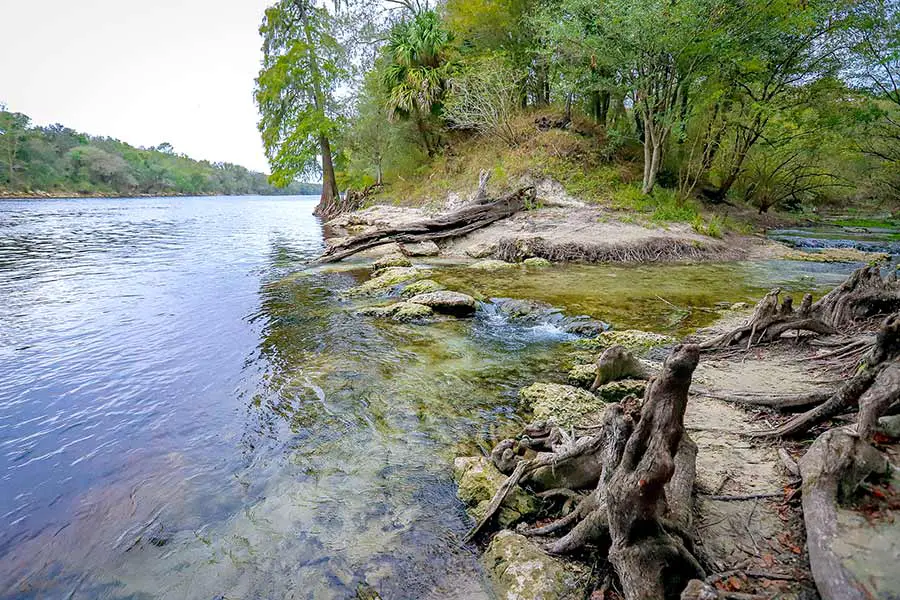
Is the Suwannee River Freshwater or Saltwater?
The Suwannee River is a freshwater river. However, you will likely notice that the river water is very dark, almost the color of tea or light-roasted coffee. The Suwannee River water is fresh, but the presence of organic material from the Okefenokee Swamp colors the water.
The dark color and heavy presence of organic runoff from the swamp have led the Suwannee to be designated as a “blackwater river.”
Don’t be worried by the name, though; the waters of the Suwannee are fresh and clean. The designation of “blackwater” is due to the organic materials in the water, not to any pollution or dangerous substances.
Is the Suwannee River a No Wake Zone?
Wake is the V-shaped wave that a boat leaves behind as it navigates through the water.
A no-wake zone is an area where the captain of a boat must operate the vessel in such a way as to generate no wake. This restriction typically means operating at speeds of below 5 miles per hour, or the minimum speed at which the vessel is steerable.
The Suwannee River has many no-wake zones, but the entire river is not a no-wake zone. No-wake zones are established and enforced by the Florida Fish and Wildlife Commission. The Suwannee River Water Management District maintains a list of current no-wake zones on the river.
Is There Good Fishing on the Suwannee River?
Freshwater fishermen will enjoy catching crappies, red bellies, and the famous Suwannee Bass. Bass fishing is hugely popular in Florida, and especially out on the Suwannee.
As the Suwannee meets the Gulf of Mexico, the water becomes brackish and then eventually becomes saltwater. Anglers will find excellent fishing as the water becomes saltier at the mouth of the Suwannee; fish like cobia, pompano, tarpon, and speckled trout are common catches.
Are There Manatees in the Suwannee River?
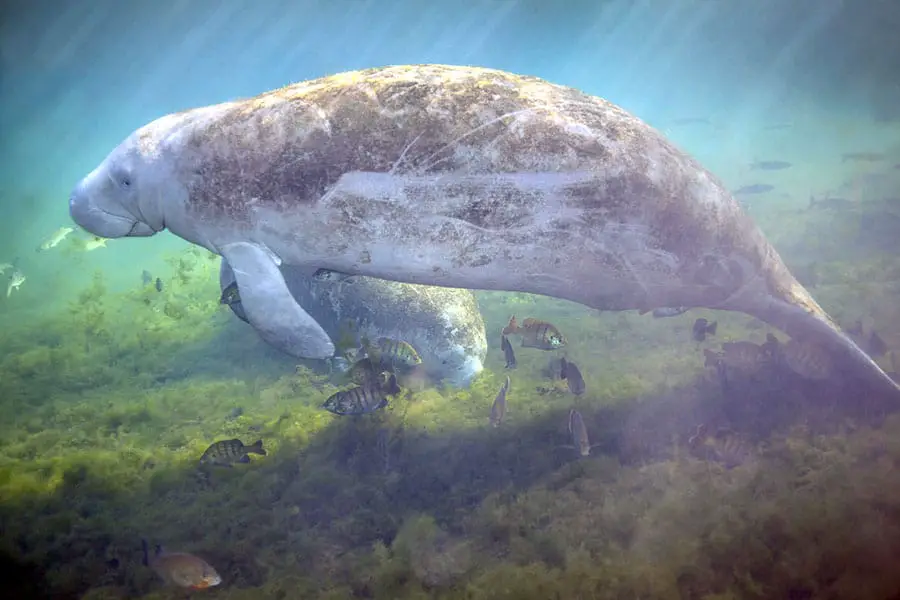
There are manatees in the Suwannee River. Manatees are amazing and beautiful animals. They are super fun to observe but remember that they are protected. They are best enjoyed with your eyes and your camera. Please do not harass the manatees.
One of the best places to see manatees along the Suwannee River is at Manatee Springs State Park. Motorboats can dock at the park’s floating dock, and passengers can then access the park by walking across a boardwalk into the spring area.
Manatee Springs State Park is a great place to see manatees, especially during the winter months, but one can find some excellent birding and nature-watching there all year round.
Are There Alligators in Suwannee River?
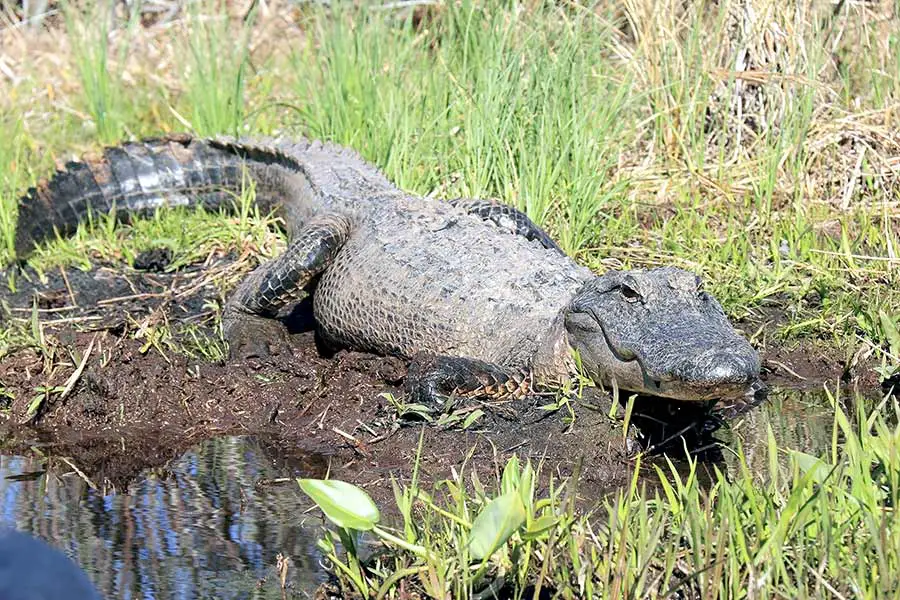
A good rule of thumb to remember in Florida is that any body of freshwater could contain an alligator.
This rule includes everything from retention ponds to water hazards to lakes and even the mighty Suwannee River. People have found them in storm drains, culverts, streams, rivers, and even swimming pools. However, they are quite at home on the Suwannee, and it’s common to see them basking in the sun along the riverbank.
While there are gators in the river, if you leave them alone, they will almost certainly leave you alone. The odds of being attacked by an alligator are about 1 in 3.2 million, so you’re not very likely at all to be attacked. That said, do not harass the alligators either. You are much more likely to have a problem if you agitate, attack, feed, entice, cajole, or otherwise irritate the gators.
In addition to alligators, the Suwannee River is home to alligator snapping turtles. Much like alligators, these creatures are not particularly interested in human beings: they are perfectly content to leave you alone and are extremely unlikely to attack.
That said, they can move deceptively quickly and have dangerous jaws that can crush human bones. So if you see one of these critters, leave it alone.
Navigating the Suwannee: Riding the River
The Suwannee River is a beautiful, unique waterway that winds its way across south Georgia and north Florida before depositing the black waters of the river into the mighty Gulf of Mexico. While the river is beautiful, parts of it are very rugged. There is even a section that can become rapids.
So while the entire Suwannee River is navigable, it is not all navigable to powered vessels. Many parts of the river, especially between the Okefenokee and Ellaville, are best suited for paddle-driven vessels such as canoes and kayaks.
But whether you’re trekking across the northern stretches with your kayak and camping gear or sleeping in your cabin cruiser down by the Gulf, you’ll have a blast out on the Suwannee.
